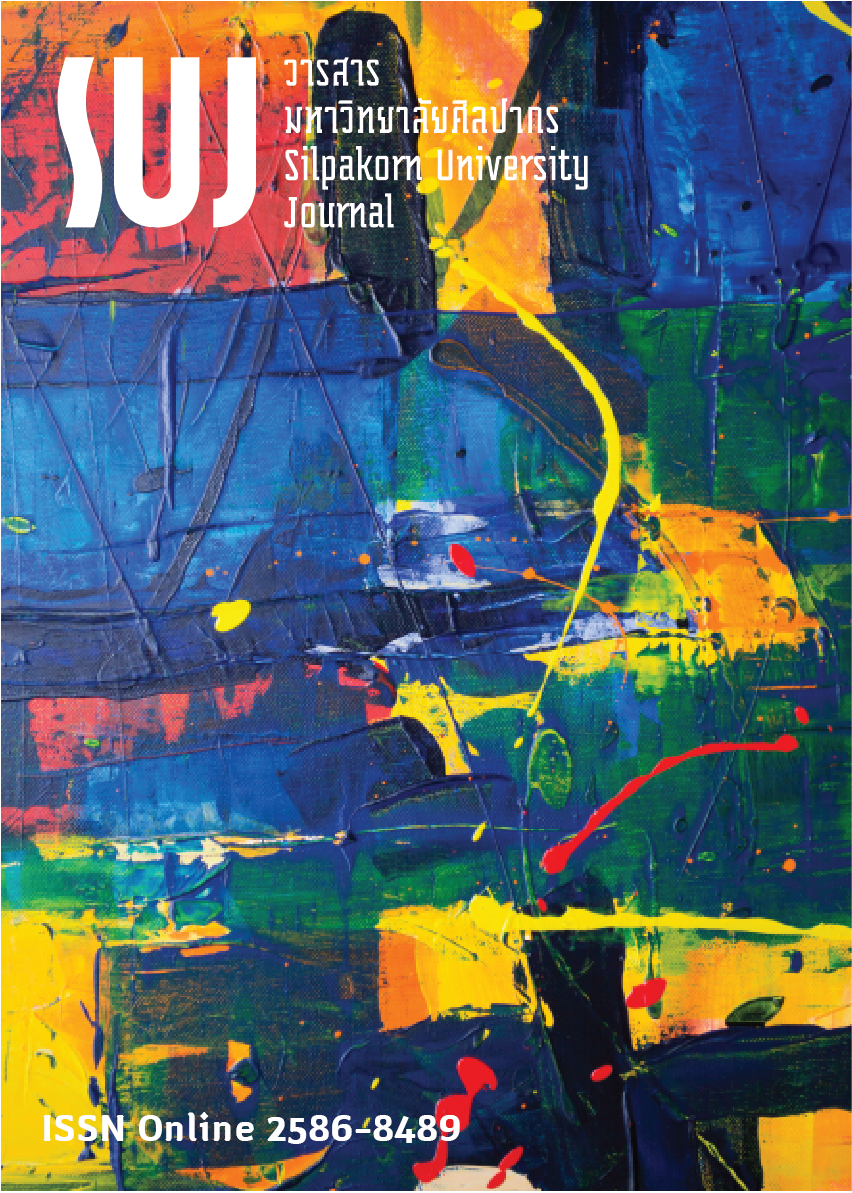การสร้างเสริมทักษะการเรียนรู้ร่วมกันในศตวรรษที่ 21 ของนิสิตระดับปริญญาตรี มหาวิทยาลัยเกษตรศาสตร์ (The promotion of collaborative learning skills in the 21st century of undergraduate students of Kasetsart University)
Main Article Content
Abstract
การวิจัยเรื่องการสร้างเสริมทักษะการเรียนรู้ร่วมกันในศตวรรษที่ 21 ของนิสิตระดับปริญญาตรี มหาวิทยาลัยเกษตรศาสตร์ใช้แบบแผนการวิจัยเชิงผสมผสาน การวิจัยระยะที่ 1 มีวัตถุประสงค์เพื่อศึกษาความต้องการจำเป็นของทักษะการเรียนรู้ร่วมกันในศตวรรษที่ 21 ของนิสิตระดับปริญญาตรี มหาวิทยาลัยเกษตรศาสตร์ กลุ่มตัวอย่างในการตอบแบบสอบถาม คือ นิสิตระดับปริญญาตรีซึ่งได้มาจากการสุ่มแบบชั้นภูมิจำนวน 400 คน ผู้ให้ข้อมูลในการสัมภาษณ์คือ อาจารย์ผู้สอนจำนวน 7 คน และนิสิตจำนวน 15 คน ซึ่งได้มาจาการเลือกอย่างเจาะจง เครื่องมือที่ใช้ในการวิจัย คือ แบบสอบถามและแบบสัมภาษณ์ ความต้องการจำเป็นของการสร้างเสริมทักษะการเรียนรู้ร่วมกันในศตวรรษที่ 21 ของนิสิตระดับปริญญาตรี วิธีการวิเคราะห์ข้อมูล คือ การวิเคราะห์ดัชนีความต้องการจำเป็นและการวิเคราะห์เนื้อหา ผลการวิจัยพบว่า องค์ประกอบที่มีระดับความต้องการจำเป็นเรียงจากสูงสุดไปต่ำสุดได้แก่ ด้านการสื่อสารและร่วมมือกันเพื่อพัฒนาการเรียนรู้มีค่า PNImodified 0.42 ด้านการเรียนรู้ร่วมกันเพื่อพัฒนาการคิดอย่างมีวิจารณญาณและการแก้ปัญหามีค่า PNImodified 0.36 ด้านการเรียนรู้ร่วมกันเพื่อพัฒนาความคิดสร้างสรรค์และสร้างแนวทางในการเรียนรู้มีค่า PNImodified 0.34 การวิจัยระยะที่ 2 มีวัตถุประสงค์เพื่อพัฒนากิจกรรมการเรียนรู้ เพื่อสร้างเสริมทักษะการเรียนรู้ร่วมกันในศตวรรษที่ 21 ของนิสิตระดับปริญญาตรี ผลการวิจัยพบว่า กิจกรรมการเรียนรู้ที่สร้างขึ้นจำนวน 12 ครั้ง แต่ละครั้งประกอบด้วยขั้นนำ ขั้นดำเนินกิจกรรมและขั้นสรุป มีค่าความสอดคล้องระหว่างวัตถุประสงค์และการออกแบบกิจกรรมระหว่าง 0.80-1.00 การวิจัยระยะที่ 3 มีวัตถุประสงค์เพื่อศึกษาผลของการใช้กิจกรรมการเรียนรู้ที่พัฒนาขึ้น กลุ่มตัวอย่างคือ นิสิตระดับปริญญาตรีในมหาวิทยาลัย เกษตรศาสตร์จำนวน 60 คน เครื่องมือที่ใช้ในการวิจัย คือ แบบวัดทักษะการเรียนรู้ร่วมกันในศตวรรษที่ 21 ของนิสิตระดับปริญญาตรีและแบบสัมภาษณ์กึ่งโครงสร้าง การวิเคราะห์ข้อมูล คือ ค่าเฉลี่ยและส่วนเบี่ยงเบนมาตรฐาน การใช้สถิติทดสอบ t-test และการวิเคราะห์เนื้อหา ผลการวิจัยพบว่า ในระยะหลังการทดลองนิสิตกลุ่มทดลองมีระดับทักษะการเรียนรู้ร่วมกันในศตวรรษที่ 21 สูงกว่าระยะก่อนการทดลองอย่างมีนัยสำคัญทางสถิติที่ระดับ .05 นิสิตกลุ่มทดลองได้ร่วมกันสะท้อนความคิดเกี่ยวกับการเรียนรู้ของตนเองและเพื่อนร่วมกลุ่ม การแลกเปลี่ยนข้อมูลเพื่อพัฒนาการเรียนและการระดมความคิดที่หลากหลายส่งผลให้นิสิตได้แนวทางใหม่ในการพัฒนาการเรียนรู้ ดังนั้นผู้ที่เกี่ยวข้องกับการจัดการศึกษาให้กับนิสิตระดับปริญญาตรีสามารถนำกิจกรรมการเรียนรู้ที่ผู้วิจัยพัฒนาขึ้นไปใช้ในการพัฒนาการเรียนรู้ของนิสิตระดับปริญญาตรีให้มีประสิทธิภาพได้อย่างสอดคล้องกับบริบทของการศึกษาในยุคปัจจุบัน
This study employs mixed research methods. The purpose of the first phase was to study the need assessment of collaborative learning skills in the 21st century among undergraduate students of Kasetsart University. The samples consisted of 400 undergraduate students of Kasetsart University. The key informants included 7 teachers and 15 undergraduate students. The instrument was the questionnaire and interview form of the need assessment of collaborative learning skills in the 21st century. PNImodified and content analysis were used for data analysis. The finding revealed that PNImodified of co-communication for learning improvement was 0.42, collaborative learning for improvement in critical thinking and problem solving was 0.36, and collaborative learning for improvement in creative thinking and creating method of learning was 0.34. The purpose of the second phase was to develop the learning activity for improvement in collaborative learning skills in the 21st century of undergraduate students that consists of 12 activities. There were 3 stages of each activities. The index of item–objective congruence of learning activities was between 0.80-1.00. The purpose of the third phase was to study the effects of using the learning activity. The sample was 60 undergraduate students. The instruments were the collaborative learning skills in the 21st century skills of undergraduate students test and the semi-structured interview form. The mean, standard deviation, t-test and content analysis were used for data analysis. The findings revealed that there was a significant difference in terms of scores on the pre-test and the post-test in the experimental group at a level of .05. By virtue of using content analysis, the undergraduate students in the experimental group took part in a discussion about their learning. They consulted in group, exchanged information and used the information to develop their learning. They brainstormed various ideas for finding methods of learning development so the educators can use the learning activity of this research for promoting learning skills of undergraduate students that was the trend in educational context.
Downloads
Article Details
References
Chalarak, Nawaporn. (2015). The Teacher’s Role and Instruction in The 21st Century (บทบาทของครูกับการเรียนการสอนในศตวรรษที่ 21). The Far Eastern University Academic Review, 9(1): 64-71.
Chantara, Rungnapa., and Sarakshetrin, Atiya. (2017). Learning Skills in 21st Century of Nursing Students at Boromarajonani College of Nursing, Suratthani (ทักษะการเรียนรู้ศตวรรษที่ 21 ของนักศึกษาพยาบาลวิทยาลัยพยาบาลบรมราชชนนี สุราษฎร์ธานี). The Southern College Network Journal of Nursing and Public Health, 4(1): 180-190.
Chaturanon, Wimonrat., Songsawat, Krisanee. and Bamrueraj, Suntorn. (2014). The Development of Instruction Model Based on Cooperative Learning And Knowledge Construction for Undergraduate Students (การพัฒนารูปแบบการเรียนการสอนตามแนวการเรียนรู้แบบร่วมมือกันสร้างความรู้สำหรับนักศึกษาหลักสูตรครุศาสตรบัณฑิต). Journal of Education and Social Development, 10(1): 151-164.
Intarakamhang, Ungsinun. (2004). Collaborative Learning to Goal Success (การเรียนรู้ร่วมกันสู่ความสำเร็จตามเป้าหมาย). The Journal of Behavioral Science, 10(1): 52-58.
Johnson, R. T. & Johnson, D. W. (1986). Action Research: Cooperative Learning in the Science Classroom. Science and Children, 24: 31-32.
Kongmalai, Benyapa., and Areesoponpichet, Sornnet. (2015). The Development of Knowledge Management Competencies for Higher Education Students in the 21st Century (การพัฒนาสมรรถนะการจัดการความรู้ของนิสิตนักศึกษา ระดับอุดมศึกษาในศตวรรษที่ 21). Journal of Education Studies, 43(1): 37-47.
Luksaneenawin, Suddaporn. (2010). Learning to change (การเรียนรู้สู่การเปลี่ยนแปลง). Bangkok: Professional and Organizational Development Network in Higher Education.
McAlpine Iain. (2000). Collaborative learning online. Distance Education, 21(1): 66-80.
Ministry of Education. (2014). How to Learning management in 21st Century. Bangkok: Ministry of Education.
Nachairit, Darunnapa., Satiman, Anirut., Thammetar, Thapanee., and Natakuatoong, Onjaree. (2016). The Development Blended Learning Model UsingCollaborativeand Case-Based Learning to Enhance Critical Thinking Problem Solving Thinking and Team Learning of Undergraduate Education Students (การพัฒนารูปแบบการเรียนการสอนแบบผสมผสานด้วยการเรียนรู้ร่วมกันโดยใช้กรณีศึกษาเพื่อส่งเสริมการคิดอย่างมีวิจารณญาณ การคิดแก้ปัญหาและการเรียนรู้ร่วมกันเป็นทีมของนักศึกษาระดับปริญญาตรี ครุศาสตร์ / ศึกษาศาสตร์). Journal of Education, Mahasarakham University, 10(3): 78-95.
Office of The Higher Education Commission. (2009). Standard of The Higher Education. [Online]. Retrieved July 9, 2017 from https://www.spu.ac.th/academic.pdf
Office The National Economic and Social Development Board. (2016). The Twelfth National Economic and Social Development Plan (2017-2021) (แผนพัฒนาเศรษฐกิจและสังคมแห่งชาติ ฉบับที่ 12 (พ.ศ. 2560-2564)). [Online]. Retrieved June 18, 2017 from https://www.spu.ac.th/academic.pdf
Panich, Wijarn. (2013). How to Learning in 21st Century. Bangkok: Siam Kammajol Foundation.
Pisalbut, Piyada., and Pasunon, Prasobchai. (2015). Learning Style of Sukhothai Thammathirat Open University Students (รูปแบบการเรียนรู้ของนักศึกษมหาวิทยาลัยสุโขทัยธรรมาธิราช). Journal of Educational Studies Sukhothai Thammathirat Open University, 8(1): 84-96.
Puengpech, Siriporn. (2016). A Study of the Learning Styles of Students in Program Interdisciplinary for Local Development Studying English for Communication and Study Skills at Chaiyaphum Rajabhat University (การศึกษาลีลาการเรียนรู้ของนักศึกษาสหวิทยาการท้องถิ่นที่เรียนภาษาอังกฤษเพื่อการสื่อสารและทักษะการเรียน มหาวิทยาลัยราชภัฏชัยภูมิ). Proceeding of The National Conference & Research Presentation 2016 The Second Decade: Integrated Research by Using the Knowledge of Sustainability, pp. 355-360, Nakorn Rajchasima.
Satraphat, Duangduen., Bunyapipat, Thirawarin., Seebuaban Kulthida. and Muksrinak, Phattarakorn. (2017). The 21st Century Teaching Styles for the Topic of Intelligence in the Introduction to Psychology Course (รูปแบบการสอนตามแนวศตวรรษที่ 21 ในวิชาจิตวิทยาเบื้องต้น เรื่อง เชาว์ปัญญา). Manutsat Paritat: Journal of Humanities, 39(1): 43-55.
Sattrapruek, Soodchalerm. (2017). Flipped Classroom in 21st Century Learning for Development of Learning and Innovation Skills (การจัดการเรียนการสอนในศตวรรษที่ 21 แบบห้องเรียนกลับด้าน เพื่อการพัฒนาทักษะการเรียนรู้และนวัตกรรม). Academic Services Journal, Prince of Songkla University, 28(1): 101-108.
Wongwanich, Suwimon. (2007). Needs Assessment Research. Bangkok: Chula Press.
Xun, Ge. & Susan., M. Land. (2003). Scaffolding students’ problem-solving processes in an ill-structured task using question prompts and peer interactions. Educational Technology Research and Development, 51(1): 21-38.


